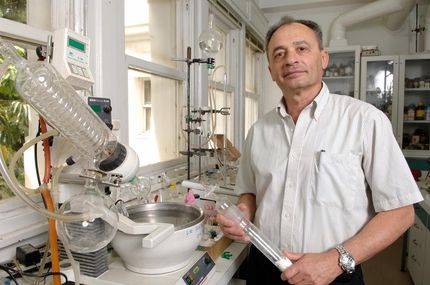Hot and cold moves of cyanide and water
Temperature determines which molecule rocks out
Scientists have long known that molecules dance about as the temperature rises, but now researchers know the exact steps that water takes with a certain molecule. Results with small, electrically charged cyanide ions and water molecules reveal that water zips around ions to a greater extent than expected. The findings improve our understanding of a chemical interaction important in environmental and atmospheric sciences.
"One of the cornerstones of Department of Energy nuclear cleanup missions and climate research is a fundamental understanding of water and ions, one of the most common chemical interactions in the environment," said chemist Xue-Bin Wang of the DOE's Pacific Northwest National Laboratory and Washington State University.
"We've developed a new instrument to probe the dynamics of ions in water," Wang said. "And we've combined theory and modeling to make sense of those experiments, giving us a deeper fundamental understanding of what is happening with this ubiquitous molecule – water."
Wang, PNNL physical chemist Sotiris S. Xantheas, physical chemist Lai-Sheng Wang of PNNL and WSU, and their colleagues published the results in the Journal of Physical Chemistry A. The journal featured their work on the cover of its September 3 issue.
Thirst for Details
Environmental scientists want to know how contaminants move through watery environments below ground, and atmospheric scientists want to know how small particles flutter through water vapor in the sky. To get at the basics, they study a simpler interaction: water and ions, small atoms or molecules that have a slight electrical charge and exist everywhere in nature.
For example, when common table salt -- sodium chloride -- dissolves in water, the negatively charged chloride ions (Cl-) and the positively charged sodium ions (Na+) each interact separately with the water molecules.
Previous work with chloride ions and water has yielded conflicting results about how a water molecule (which is shaped like a boomerang) and a chloride ion (shaped like a ball) face each other. Other groups study barbell-shaped cyanide ions because many molecules found naturally in the environment contain cyanide. The chemical interactions of water and either chloride or cyanide are influenced by the charge and the shape of the molecules, as well as the temperature in which they find themselves.
But directly observing temperature's role in how water and cyanide ions interact has been difficult. So, the team developed a unique instrument that allowed them to precisely control the temperature down to almost absolute zero, or the temperature at which everything freezes. The team used "temperature-controlled photoelectron spectroscopy" in EMSL, the DOE's Environmental Molecular Sciences Laboratory on the PNNL campus, to determine how tightly one cyanide ion and one to three water molecules interact at the very low temperature of -438 F (12 Kelvin) and again at ambient temperature of 80 F (equivalent to 300 Kelvin).
Unexplained Energy
The team measured the molecules' "electron binding energy" at low and high temperatures. This energy is an indication of how tightly the molecules hold onto their electrons -- the tighter the hold, the stronger the bonds that will form between molecules. The team found that ones at low temperature exhibited higher electron binding energy than the ones at high temperatures, as they had expected. However, the difference between the two scenarios was greater than the team expected.
To explore the unexpected difference in energy, the researchers ran computer simulations on the Chinook supercomputer in EMSL. This also let them determine how the boomerang-shaped water and barbell-shaped cyanide faced each other. First they estimated how much energy the molecules used to take different configurations. Then they compared the computer-based estimates to the data they collected in their unique instrument at different temperatures.
The team found that the molecules behaved differently at cold and warm temperatures. At lower temperatures, the boomerang-shaped water held still while the cyanide teetered at the end of one of water's two arms. There, the cyanide flipped, sometimes pointing its carbon (C) atom towards the water's arm, and sometimes pointing its nitrogen (N). At the coldest temperature tested, -438 F, the molecules froze, with cyanide pointing its nitrogen end at the water.
Hot to Trot
At ambient temperatures, however, the barbell-shaped cyanide held steady while the water molecule rocked and flipped around the cyanide. Although the researchers were surprised at how much the water moved, the many positions water could take explained why they saw less electron binding energy than they expected at room temperature: A wiggly water means that the bond between molecules isn't that tight.
"Water can interact with cyanide's carbon or nitrogen and rock back and forth on one atom," said Wang. He added that the detail they get with this instrument is impressive. "Scientists have known for years that atoms move around when temperature rises. Now they can determine the most probable position that the molecule is in at different temperatures."
The results also explain the conflicting results with chloride ions and water, the researchers said, because of the importance of temperature on that interaction as well.
The researchers plan to follow up with studies that include many water molecules and ions at once, as well as with more complex ions than cyanide.
Original publication: Xue-Bin Wang et al.; "Observation of a Remarkable Temperature Effect in the Hydrogen Bonding Structure and Dynamics of the CN-(H2O) Cluster"; . Phys. Chem. A 2009, 113 (35), pp 9579-9584



























































